Just a few short days after Hurricane Maria devastated nearly everything in its path, the Western Area Power Administration (WAPA), which is part of the U.S. Department of Energy, quickly deployed two dozen linemen to the U.S. Virgin Islands to begin the arduous task of restoring power to the area.
The contingent of journeymen linemen – which included seven IBEW 1245 members from WAPA’s Sierra Nevada region, as well as other linemen from around the country – were stationed in St. Thomas for two full months as they worked tirelessly in exceptionally difficult conditions to help re-energize the island and get it back on its feet.
Maria’s Toll
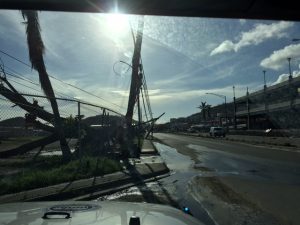 The team from WAPA was tasked with repairing and heating up the transmission system from the St. Thomas power plant to its four main substations (one of which was connected to St. John via a submarine cable, so their work would enable that small island to regain power as well).
The team from WAPA was tasked with repairing and heating up the transmission system from the St. Thomas power plant to its four main substations (one of which was connected to St. John via a submarine cable, so their work would enable that small island to regain power as well).
This is fairly commonplace work for experienced linemen, but when they arrived on the island of St. Thomas in late September, they quickly realized that the job would be anything but ordinary. Even those with a wealth of post-storm restoration experience were blown away by the extent of the damage.
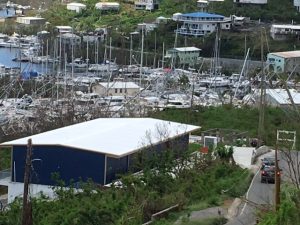 “I worked [restoration] after Hurricane Sandy, but this was completely different,” said 19-year IBEW 1245 member Brian Adams, who works as a line foreman for WAPA out of Redding. “With Sandy, there was still some infrastructure and power within driving distance. But when we got to St. Thomas, there was nothing — no power at all anywhere throughout the island. The amount of work that was needed just to get their basic infrastructure – water desalination facilities, hospitals, that kind of stuff – back up, it was amazing to me.”
“I worked [restoration] after Hurricane Sandy, but this was completely different,” said 19-year IBEW 1245 member Brian Adams, who works as a line foreman for WAPA out of Redding. “With Sandy, there was still some infrastructure and power within driving distance. But when we got to St. Thomas, there was nothing — no power at all anywhere throughout the island. The amount of work that was needed just to get their basic infrastructure – water desalination facilities, hospitals, that kind of stuff – back up, it was amazing to me.”
No Easy Feat
 Although their equipment had been shipped out prior to the storm, the linemen still faced innumerable challenges when it came to simple logistics, which became quite apparent when a bucket truck needed to be repaired.
Although their equipment had been shipped out prior to the storm, the linemen still faced innumerable challenges when it came to simple logistics, which became quite apparent when a bucket truck needed to be repaired.
“Being on the island, we couldn’t just call over to the [mainland] and say we have issues with equipment. It was a lot harder than that,” said Adams. “It took about two-and-a-half weeks to get a replacement bucket shipped from Altec to St. Thomas. If we’d been anywhere else, we could have it the next day. But there was no UPS, no Fedex, and not a lot of flights going in or out, and that made it really difficult.”
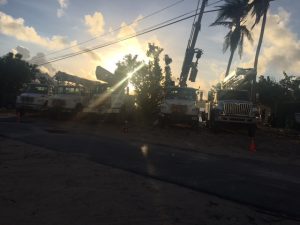 Supplies and materials proved to be one of the biggest challenges that the crews faced each day, simply due to the fact that there was so little on hand, and acquiring the necessary parts and pieces involved both tenacity and ingenuity.
Supplies and materials proved to be one of the biggest challenges that the crews faced each day, simply due to the fact that there was so little on hand, and acquiring the necessary parts and pieces involved both tenacity and ingenuity.
“We were setting a lot of poles, so we ended up re-using all the wire we could get from the downed poles, but our biggest issue was with the other stuff, like bolts, nuts, flat washers and insulators,” Adams explained. “We showed up so quickly after the storm that FEMA hadn’t yet gotten all the materials there. Once the materials started to trickle in, there were also a lot of other linemen showing up who needed it too, so every day was a mad dash to get to the warehouse in order to get what we needed for the day.”
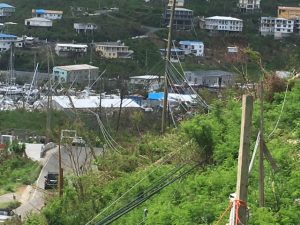 The crews faced other challenges as well, both natural and man-made. They had to contend with steep, rocky terrain and downed vegetation, which made digging pole holes more difficult, as well as unpredictable weather, with high temperatures and humidity close to 100%, intermixed with massive tropical rainstorms that would blow in aggressively and dump inches of rain in a matter of minutes. Navigating the roads also proved to be no easy feat. In St. Thomas, residents drive on the left side of the street – which can take quite a bit of getting used to for individuals who’ve spent their entire lives driving on the right. Traffic control was difficult, and roadway hazards were everywhere, but fortunately the crews managed it well and returned home with no accidents or injuries.
The crews faced other challenges as well, both natural and man-made. They had to contend with steep, rocky terrain and downed vegetation, which made digging pole holes more difficult, as well as unpredictable weather, with high temperatures and humidity close to 100%, intermixed with massive tropical rainstorms that would blow in aggressively and dump inches of rain in a matter of minutes. Navigating the roads also proved to be no easy feat. In St. Thomas, residents drive on the left side of the street – which can take quite a bit of getting used to for individuals who’ve spent their entire lives driving on the right. Traffic control was difficult, and roadway hazards were everywhere, but fortunately the crews managed it well and returned home with no accidents or injuries.
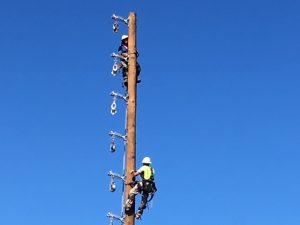 Despite all these challenges and more, the WAPA team still managed to complete their mission safely and ahead of schedule, which allowed them to use their remaining time working on other aspects of the electrical system that needed repair.
Despite all these challenges and more, the WAPA team still managed to complete their mission safely and ahead of schedule, which allowed them to use their remaining time working on other aspects of the electrical system that needed repair.
Life on the Island
Nearly all of the housing accommodations in the Virgin Islands were destroyed in the hurricane, so during their two-month stay in the Caribbean, the WAPA crews were housed on a boat – three different boats, to be precise. When they first arrived, they were stationed on the SS Wright, a logistics support ship on loan to FEMA during the aftermath of the hurricane. The quarters were far from spacious, with 70 men to a room, sleeping in triple-bunks and sharing just four bathrooms. After a few weeks, Adams and his crew were relocated to the Ocean Constructor, a small cargo ship with shipping containers that had been converted into living quarters. After spending 10 days on that ship, they were able to move over to a cruisliner that had been dispatched to house the crews and other aid workers, and those accommodations were downright luxurious, particularly compared to the first few weeks on the SS Wright.
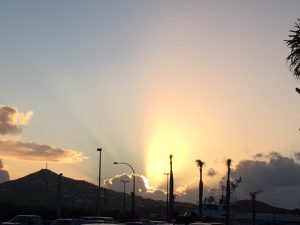 Despite the less-than-ideal conditions at times, along with the 13-hour workdays and no days off, Adams and his crew had no complaints, especially after witnessing what the residents of St. Thomas had to contend with, and how well they managed it all.
Despite the less-than-ideal conditions at times, along with the 13-hour workdays and no days off, Adams and his crew had no complaints, especially after witnessing what the residents of St. Thomas had to contend with, and how well they managed it all.
“These people had just been through two back-to-back hurricanes, and yet the vast majority of the people we met were very, very nice, and very happy to see us there, working to get the system restored,” said Adams. “They went on every day like it was just the same, even though many of them were living in homes with no roofs. They seemed to take it all in stride. They’re strong people, they just kept on going where others might have just given up… and they we so gracious and willing to help.”
 Adams recalled one unique experience with some of the locals that really resonated with him.
Adams recalled one unique experience with some of the locals that really resonated with him.
“When we were staying on the SS Wright, there was no place to side down and relax; you could either lay in your cot or sit in the caf, which was always crowded and noisy,” said Adams. “We started going over to this little local restaurant that was right near the boat, and we built a good relationship with the owner and bartender … so on days when we’d come in late, they had food prepared for us. Now this wasn’t food that they made in the restaurant; they were bringing it from their homes, and remember they didn’t have any light or electricity! Truthfully, the food on the ship was pretty much always the same thing, cooked in bulk, so to come in and have this local island food prepared for us, it was awesome and delicious. They fact that they were doing that for us … I just thought that was a really neat experience.”
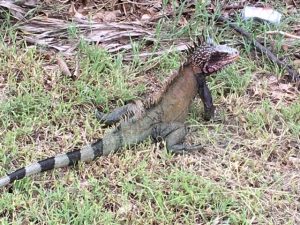 “It was nothing we would have expected from them, because we knew how much they’d lost in the storm, and that they had very little,” Adams continued. “But they were so kind to us. Almost everyone we met down there was willing to help any way they could. And I got a kick out of learning about their culture, it’s very unique and I’d never experienced anything like that before.”
“It was nothing we would have expected from them, because we knew how much they’d lost in the storm, and that they had very little,” Adams continued. “But they were so kind to us. Almost everyone we met down there was willing to help any way they could. And I got a kick out of learning about their culture, it’s very unique and I’d never experienced anything like that before.”
–Rebecca Band, IBEW 1245 Communications Director
Photos by Brian Adams